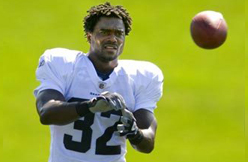RENTON -- Welcome once again to running back roulette.
Not as high profile as hiring Brett Favre or Michael Vick, or having a player shoot a hole in his thigh. But it's the best the Seahawks can do in the preseason to stir interest in their little outpost.
At least there is local some tradition to running back roulette. Last year's mystery was why the ordinary Maurice Morris was promoted midseason over the more celebrated newcomer, Julius Jones.
Before that, fans couldn't wait to get rid of the most productive runner in club history, Shaun Alexander.
Back when Alexander was shiny and new, everyone wanted him to start in favor of Rickey Watters.
But the best comparison in club history to the events of this week goes back 25 years.
While it's true that anyone who saw Edgerrin James, who signed Tuesday night, slash for 100 yards in 14 carries in a Dec. 30 game has no business comparing James to Franco Harris, it's also true that James's feat came against the Seahawks defense.
Point, counterpoint.
Where the situations do beg for comparison is the injury desperation that gripped both Seahawks teams.
In 1984, star running back Curt Warner was lost in the first game. This time, most of the offensive line is out before the first game, and the nominal starter at running back, Julius Jones, was hurt temporarily last week.
Franco, the Hall of Famer from the Pittsburgh Steelers, was hired at the end of his otherwise stellar career and delivered a cellar performance -- eight games, six starts at fullback and 170 yards rushing in 68 carries. The joke was that Harris still showed a burst only when hustling to the sidelines to avoid contact.
Now, James, 11th in NFL history in rushing yards -- he has one more career yard than No. 12 Franco -- has been asked to postpone his athletic dotage to bail out a Seahawks offense suddenly looking as vulnerable as health care reform.
James, whose photo on NFL.com bore a Seahawks jersey while negotiations dragged on into the early evening, presumably will be available for duty Saturday in the Seahawks' third exhibition game in Kansas City.
Which is more than can be said for tackle Walter Jones, guard Mike Wahle and center Chris Spencer. Injuries have taken out three-fifths of a line that last season wasn't all that good even healthy, leaving inexperience scattered nearly everywhere.
After watching quarterback Matt Hasselbeck get sacked three times in the half-game he played Saturday, pass protection loomed as least as sweaty a subject as the lack of forward progress on the ground.
At this juncture, the Seahawks are highly unlikely to add a starter to the line. But in James, they at least have a veteran running back who gained 236 yards (3.9 average) in the four postseason games of the Arizona Cardinals' stupefying run to the Super Bowl in February -- after he posted 100 against the Seahawks.
So recent history suggests that, even if James's longest gain last season was 16 yards, the four-time Pro Bowler in his heyday as an Indianapolis Colt appears capable of the between-the-tackles labor that will be more adequate than the running back he supplanted, T.J. Duckett.
Besides his newcomer status and absent a training camp, the biggest issue is that James turned 31 Aug. 1. Those who recall the near-limitless discussion of NFL actuarial tables surrounding Alexander's final days in Seattle will remember that expiration date of the most heavily used running backs is a consistent 30 years of age.
After his Super Bowl season of 2005 when he gained 1,880 yards at age 28, Alexander played only 27 more games, including four in 2008 with the Washington Redskins after his Seahawks career ended. Well before that, he was done, thanks to the pounding.
A more flattering Seahawks comparison for James would be Watters, who in his 31st year in 2000 gained 1,242 yards, a 4.5 average, and had seven touchdowns. By next season, he was done -- four games, 318 yards.
When it goes, it goes fast for running backs.
Even James can't know how his body will respond. As far as his attitude, that isn't what kept him out of the Arizona lineup for several games last season.
A rookie running back, Tim Hightower, drew the favor of coach Ken Whisenhunt. When James said his predictable piece about absence of touches, he was benched. In light of James' subsequent postseason production, a case can be made that coaching vindictiveness was a larger impediment to James than a decline in productivity.
The Cardinals let him go into free agency. His agent, Drew Rosenhaus, bet that some team in preseason would come up lame. The Seahawks' travails of the last week put them in his crosshairs, and Rosenhaus spent all day at Seahawks headquarters convincing Seahawks GM Tim Ruskell that the team had little choice but to accept the risk.
In case you were wondering, that 1984 Seahawks team wasn't hurt by the failed risk in signing Harris.
Despite the fact that their leading rusher ended up being an obscure fullback named David Hughes, who registered 327 yards and one touchdown, the Seahawks went 12-4 thanks to a ferocious defense led by Kenny Easley, and a quarterback named Dave Krieg, who made the Pro Bowl throwing to Steve Largent.
Such luxuries appear unavailable to the 2009 Seahawks. No part of this team appears capable of carrying other parts.
If a desperate offense gets tossed a life ring that's a little tattered and discolored, but still floats, fashion would seem to take a backseat.

(seattlepi.com)


